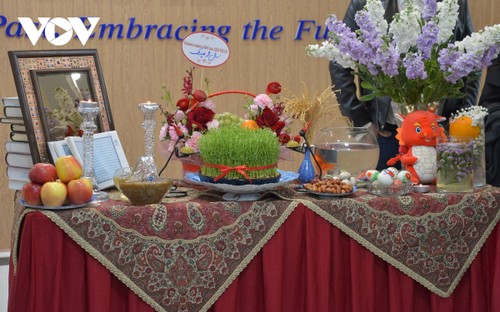 A close-up of the haft-sin table prepared by Iranians on the 1st day of the traditional Nowruz New Year. (Photo : Trung Hieu) A close-up of the haft-sin table prepared by Iranians on the 1st day of the traditional Nowruz New Year. (Photo : Trung Hieu)
|
When the equinox comes, millions of Iranian families gather around a ceremonial table known as the haft-sin, the essence of Nowruz, which means 'new day' in Persian. Young and old hold hands and count down to the New Year together and cheer Happy New Year!
Nowruz is the most important festival of the year in Iran and in countries across the Middle East, Central Asia, South Asia, the Balkans, and East Africa.
The holiday dates back at least 3,000 years, but has changed over the years, with different regions preserving or abandoning different traditions, as well as adding new ones. Wherever it is observed, however, it still celebrates rebirth and renewal.
The haft-sin table is a relatively recent addition to Nowruz, which usually falls on March 20 or 21 of the solar calendar.
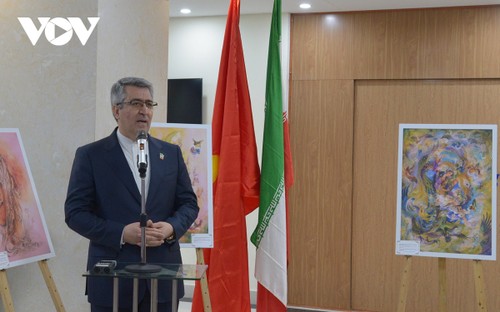 Iranian Ambassador to Vietnam Ali Akbar Nazari speaks at the Nowruz ceremony held for the first time at the University of Social Sciences and Humanities under Vietnam National University Hanoi. (Photo: Trung Hieu) Iranian Ambassador to Vietnam Ali Akbar Nazari speaks at the Nowruz ceremony held for the first time at the University of Social Sciences and Humanities under Vietnam National University Hanoi. (Photo: Trung Hieu)
|
Iranian Ambassador to Vietnam Ali Akbar Nazari told us that Iranians decorate their home for the new year with something called ‘haft-sin’.
"In every Iranian family on New Year’s day a tray of haft-sin is prepared, a symbol of Nowruz in Iran and other countries that celebrate Nowruz. It’s a tray of seven items whose name starts with the letter ‘S’ in Persian. The number 7 is considered sacred in Iranian culture,” said Ambassador Nazari.
As Nowruz is associated with agriculture and is oriented towards community and family, the required items on a haft-sin table are all agricultural products: wheat or bean sprouts (sabze), symbolizing rebirth; vinegar (serkeh), symbolizing age and patience; apples (sib), representing beauty; garlic (seer), a symbol of medicine; a wheat-based pudding (samanu), a symbol of affluence; a red spice (sumac) the color of the rising sun; and a kind of wild olive (senjed), representing love.
“In addition to these things that convey their hopes and wishes, Iranians also display other things: a Holy Quran, coins, colored eggs, goldfish, mirrors, candles, or watery books by Hafez or Ferdowsi (books of wisdom),” said Ambassador Nazari.
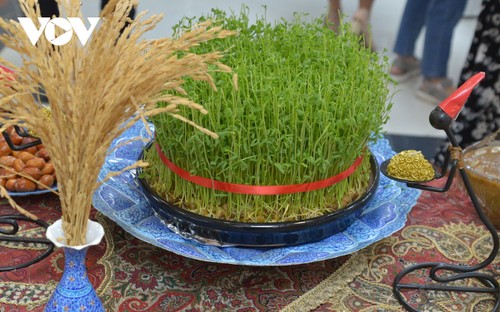 The center of the half-sin table is a tray of sabze or wheat or bean sprouts symbolizing rebirth and freshness. (Photo : Trung Hieu) The center of the half-sin table is a tray of sabze or wheat or bean sprouts symbolizing rebirth and freshness. (Photo : Trung Hieu)
|
According to Ambassador Nazari, painted eggs represent fertility, a mirror symbolically reflects the past year, goldfish represent new life, and candles suggest light and happiness.
A variety of other items might be prepared for the haft-sin table, but the preparation is always a family activity that usually begins by spreading a special cloth on the table on which are placed the seven S items.
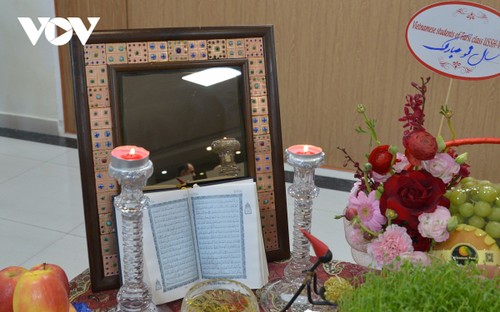 Iranians believe that the mirror symbolically reflects the past year and can drive away bad elements. (Photo : Trung Hieu) Iranians believe that the mirror symbolically reflects the past year and can drive away bad elements. (Photo : Trung Hieu) |
This year, the Nowruz ceremony, the 1,403rd edition according to the Persian calendar, was held for the first time in Hanoi.
“In 2010 the United Nations General Assembly recognized an International Day of Nowruz. That means Nowruz is a day for the world, not just for one person or one country. In 2016 Nowruz was designated an intangible heritage of humanity by UNESCO. This is a source of pride for all Iranians,” Ambassador Nazari elaborated.
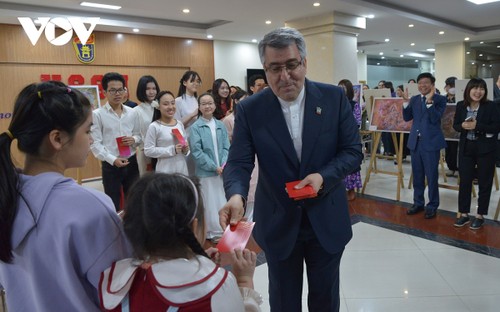 As in Vietnam, Iranians also have a tradition of giving lucky money to youngsters and children, a practice called “Eidi”, during Nowruz. (Photo : Trung Hieu) As in Vietnam, Iranians also have a tradition of giving lucky money to youngsters and children, a practice called “Eidi”, during Nowruz. (Photo : Trung Hieu)
|
As in Vietnam, this is the Year of Dragon in Persian tradition. And as in Vietnam, during Nowruz, adults give lucky money to youngsters and children, a practice called “Eidi”.
Usually, they will put a few new banknotes between the pages of a “book of wisdom” (the Quran, the Avesta, or the divan of Hafiz) and as soon as the new year begins, they open the book and give the money to younger family members.